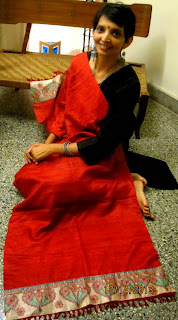It is often baffling to discover something so beautiful and
unique in the most unexpected places. One such discoveries was that of Madhubani
Paintings. It was during the year 1934 that Bihar had suffered one of the worst
earthquakes in history. A magnitude of 8.1 on the Richter scale swept clean, vast areas of many towns. It was under this Natural devastation that a British colonial officer William G. Archer caught the first
glimpses of the Madhubani Paintings. Seeing a strong similarity to works of modern western artists
like Picasso, Miro and Klee and impressed by the beauty and geometrical
patterns, it was first promoted through various art journals. As such the
Madhubani Art form was first exposed to the whole world.
This art form’s
heritage goes back at least 2500 years during the time of the Ramayana. It is
believed that King Janak had commissioned artists to come up with paintings
during the time of marriage of Sita and Ram. Through generations this folk
painting of Northern India has mostly been practiced by women and their
daughters in villages of Mithila , in modern day Bihar an area near the border of India and Nepal.
The paintings focus on nature and mythology and depict different events like
birth, marriage etc. through the various cycles of life. The central theme
revolves around love, valour, devotion and fertility. It is common to find
various symbols of prosperity in these paintings such as fish, elephant, bamboo
tree, moon, sun, parrot, peacock , lotus
etc. The central figures in the paintings are the divine beings surrounded by
colourful motifs and flora. The human beings are usually abstract and linear in
form. It is also common to find Hindu deities depicted such as Durga, Krishna,
Saraswati, Ram and Shiva.
The artists of
Madhubani Paintings still use the traditional way of mixing colour derived
naturally from nature. For example yellow is prepared from turmeric or lime is
mixed with the white excretion of banyan tree to give it a yellow colour. Orange
comes from palasa flower, green from bilva leaf and red from kusum. Twigs with
cotton wrapped around their tips are used as brushes. Mithila is known not only
for its paintings but also for its rich culture and various scholar, poets and
theologians. Before painting on paper began the women of the village usually
confined themselves to their homes and practised wall paintings during rituals.
Nowadays these
same women are being given local, national and even international recognition. They
have become an important part of the family income. The title has been changed
from “folk artists” to “contemporary artists”. They are a few men however who
too practice this so called “women’s tradition” with the same enthusiasm.
The Madhubani
paintings can be categorized into Traditional, Monochrome, Tattoo, Contemporary
and Animals & Birds. The paintings can be distinguished by the use of
vibrant colours, geometric and floral patterns, abstract figures of deities. Versatility
is another aspect of this art form due to which it has varied applications. Be
it artefacts, Mask figures, saris and textiles, wall paintings, mud wall
paintings, Tea coasters or coffee tables. It is surprising to find so much
hidden talent in India.
Despite the
recognition received, many styles of
Madhubani Painitngs have become extinct due to lack of encouragement and takers
for the art. 1970 was a celebrated year as the government gave official
recognition to this art.
At Banna we not
only promote this art form but have also encouraged and supported several
traditional Madhubani artists by extending the applications of their Madhubani
art work.
We have our own
line of custom made Madhubani Sarees and textiles, in specialised designs. Each
of these pieces is not only reflective of this age old art form but is also an
active and singular means of livelihood for the artists.
- contributed by Antorik Roy for Banna Creations !
- contributed by Antorik Roy for Banna Creations !




No comments:
Post a Comment